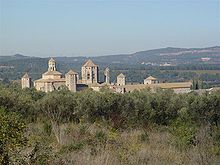Poblet
| Poblet Monastery | |
|---|---|
 |
|
| Basic information | |
| Location | Vimbodí i Poblet, Catalonia, Spain |
| Geographic coordinates | 41°22′51″N 1°04′57″E / 41.380833°N 1.0825°ECoordinates: 41°22′51″N 1°04′57″E / 41.380833°N 1.0825°E |
| Affiliation | Roman Catholic Church |
| Leadership | Abott Josep Alegre |
| Website | www |
| Architectural description | |
| Architect(s) | Arnau Bargués |
| Architectural type | Monastery |
| Architectural style | Catalan Gothic |
| Official name: Poblet Monastery | |
| Criteria | i, iv |
| Designated | 1991 |
| Reference no. | 518 |
| Official name: Monasterio de Poblet | |
| Designated | 13 July 1921 |
| Reference no. | (R.I.)-51-0000197-00000 |
The Royal Abbey of Santa Maria de Poblet (Catalan: Reial Monestir de Santa Maria de Poblet) is a Cistercian monastery, founded in 1151, located at the feet of the Prades Mountains, in the comarca of Conca de Barberà, in Catalonia (Spain). It was founded by Cistercian monks from France on lands conquered from the Moors. The main architect was Arnau Bargués.
This monastery was the first of three sister monasteries, known as the Cistercian triangle, that helped consolidate power in Catalonia in the 12th century. (The other two are Vallbona de les Monges and Santes Creus.)
Poblet was the royal pantheon of the kings of the Crown of Aragon since James I of Aragon. Some of the most important royal sepulchres have alabaster statues that lie over the tomb. The kings have lion sculptures at their feet, while the queens have dogs.
Peter IV of Aragon (1319 – 1387) made it a condition, under solemn oath at the moment of crowning, that all the Aragonese kings be buried there. Only Ferdinand II of Aragon broke the oath, after his kingdom had been merged with the Kingdom of Castile, and was buried in Granada.
The following kings and queens of Aragon are buried at the Poblet Monastery:
Additional notable figures interred here include the Hungarian queen Beatrice of Naples (1508) and Philip Wharton, 1st Duke of Wharton (1731).
The tombs of the royals were restored by the Catalan sculptor Frederic Marés in 1948.
...
Wikipedia
